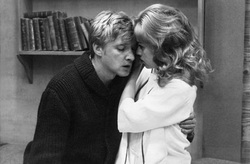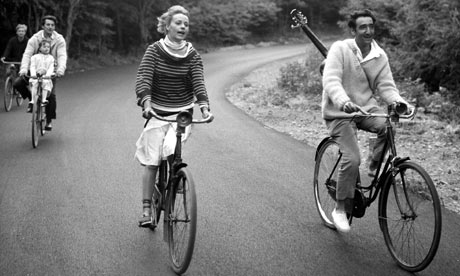
Jules and Jim was the first French New Wave film that I watched, so naturally I mostly paid attention to the plot and beautiful scenery. However, after doing some more research, thanks to the internet, I re-watched the film and discovered the genius behind Truffaut's camera work. Truffaut used wide camera angles, and jump cuts to symbolize moods within each scene. Jump cuts are a crude way of editing where the film just skips to another scene without any transition. When I say wide camera angles I mean the difference between a close up and a 180 degree panoramic shot. Truffaut set the tone for the rest of the French New Wave movement with these editing skills. So, like I said earlier, the director used these two techniques to demonstrate a certain mood, or vibe within the scene. For example, when Jules and Jim both meet Catherine for the first time the audience can clearly see the awe and daze in the two men's eyes. However, Truffaut also makes the audience feel confused, and bewildered because of the way the scene and shots play out. Flashback to the beginning of the movie where Jules and Jim become infatuated with the beautiful statue of a women smiling. The audience remembers the quick, disconnected close ups on the statues face and the long slow seemingly breathtaking shots of the statue garden. The shots are jumpy, and often do not move in a linear up and down or side to side fashion. The audience clearly is confused. Truffaut then makes this confused connection once again in the scene where the men meet Catherine by having quick jump cuts and slow close ups on Catherine's face exactly like they were on the statue. Truffaut is showing the viewers how it feels to be caught off guard completely amazed, and in a euphoric daze.
Another example of Truffaut using his camera to manifest certain feelings is during the scene with Thèrése, a one night stand. It is a happy, playful time is Jim's life and the scene clearly shows it. The camera does a complete 360 around the two as Thèrése puffs smoke out her mouth like a steam engine. With each puff, the camera seems to make a playful jump, not as sudden as a jump cut, but physically moving it up and down like two giddy young girls playing "ring around the rosey" . The two seem to be in complete happiness and are placed in the center of the room, while as I said earlier, the camera rotates around. In direct contrast, Truffaut shows Jim and another lover, Gilbert, sitting miserably in the corner of a room. Gilbert and Jim are stuffed in a tiny bed in the corner. They are filmed slowly and smoothly with shots moving left to right which makes it feel boring and sad for the audience. Placing them in the corner also shows the audience that Gilbert is not in the center of Jim's life. There are many more examples to be found in Jules and Jim see if you can find some. I highly recommend the film, not just because it is a classic, and started off the movement with a bang, but also because it tells a bizarre but touching love story and who doesn't love that.

 RSS Feed
RSS Feed